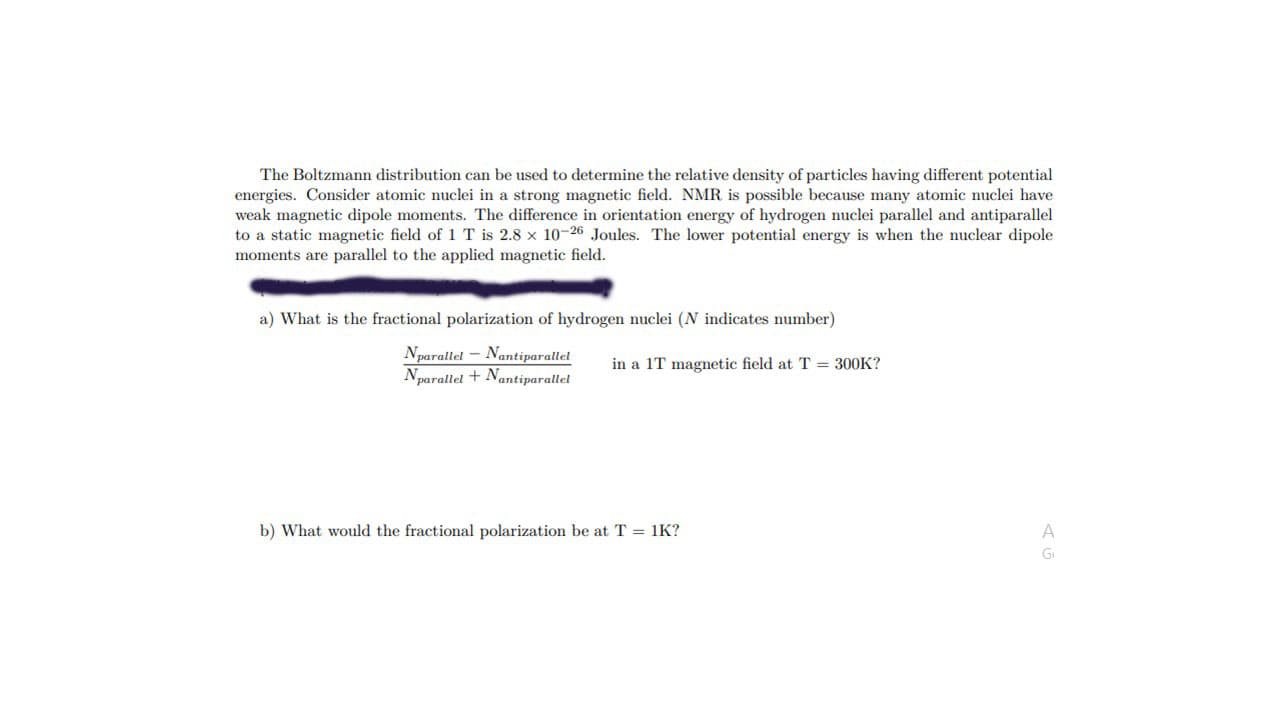The Boltzmann distribution can be used to determine the relative density of particles having different potential energies. Consider atomic nuclei in a strong magnetic field. NMR is possible because many atomic nuclei have weak magnetic dipole moments. The difference in orientation energy of hydrogen nuclei parallel and antiparallel to a static magnetic field of 1 T is 2.8 x 10-26 Joules. The lower potential energy is when the nuclear dipole moments are parallel to the applied magnetic field. a) What is the fractional polarization of hydrogen nuclei (N indicates number) Nparallel – Nantiparallel Nparallel + Nantiparallet in a 1T magnetic field at T = 300K? b) What would the fractional polarization be at T = 1K? A
The Boltzmann distribution can be used to determine the relative density of particles having different potential energies. Consider atomic nuclei in a strong magnetic field. NMR is possible because many atomic nuclei have weak magnetic dipole moments. The difference in orientation energy of hydrogen nuclei parallel and antiparallel to a static magnetic field of 1 T is 2.8 x 10-26 Joules. The lower potential energy is when the nuclear dipole moments are parallel to the applied magnetic field. a) What is the fractional polarization of hydrogen nuclei (N indicates number) Nparallel – Nantiparallel Nparallel + Nantiparallet in a 1T magnetic field at T = 300K? b) What would the fractional polarization be at T = 1K? A
Related questions
Question

Transcribed Image Text:The Boltzmann distribution can be used to determine the relative density of particles having different potential
energies. Consider atomic nuclei in a strong magnetic field. NMR is possible because many atomic nuclei have
weak magnetic dipole moments. The difference in orientation energy of hydrogen nuclei parallel and antiparallel
to a static magnetic field of 1 T is 2.8 x 10-26 Joules. The lower potential energy is when the nuclear dipole
moments are parallel to the applied magnetic field.
a) What is the fractional polarization of hydrogen nuclei (N indicates number)
Nparallel – Nantiparallel
Nparallel + Nantiparallet
in a 1T magnetic field at T = 300K?
b) What would the fractional polarization be at T = 1K?
A
Expert Solution
This question has been solved!
Explore an expertly crafted, step-by-step solution for a thorough understanding of key concepts.
This is a popular solution!
Trending now
This is a popular solution!
Step by step
Solved in 2 steps with 2 images
